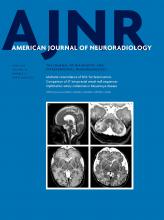Abstract
BACKGROUND AND PURPOSE: Early and accurate identification of tumor progression in patients with low-grade gliomas is challenging. We aimed to assess the role of quantitative ADC analysis in the sequential follow-up of patients with low-grade gliomas as a potential imaging marker of tumor stability or progression.
MATERIALS AND METHODS: In this retrospective study, patients with a diagnosis of low-grade glioma with at least 12 months of imaging follow-up were retrospectively reviewed. Two neuroradiologists independently reviewed sequential MR imaging in each patient to determine tumor progression using the Response Assessment in Neuro-Oncology criteria. Normalized mean ADC (ADCmean) and 10th percentile ADC (ADC10) values from FLAIR hyperintense tumor volume were calculated for each MR image and compared between patients with stable disease versus tumor progression using univariate analysis. The interval change of ADC values between sequential scans was used to differentiate stable disease from progression using the Fisher exact test.
RESULTS: Twenty-eight of 69 patients who were evaluated met our inclusion criteria. Fifteen patients were classified as stable versus 13 patients as having progression based on consensus reads of MRIs and the Response Assessment in Neuro-Oncology criteria. The interval change of ADC values showed greater concordance with ultimate lesion disposition than quantitative ADC values at a single time point. The interval change in ADC10 matched the expected pattern in 12/13 patients with tumor progression (overall diagnostic accuracy of 86%, P <.001). On average, the ADC10 interval change predicted progression 8 months before conventional MR imaging.
CONCLUSIONS: The interval change of ADC10 values can be used to identify progression versus stability of low-grade gliomas with a diagnostic accuracy of 86% and before apparent radiologic progression on conventional MR imaging.
ABBREVIATIONS:
- LGG
- low-grade glioma
- ROC
- receiver operating characteristic
- © 2018 by American Journal of Neuroradiology
Indicates open access to non-subscribers at www.ajnr.org












